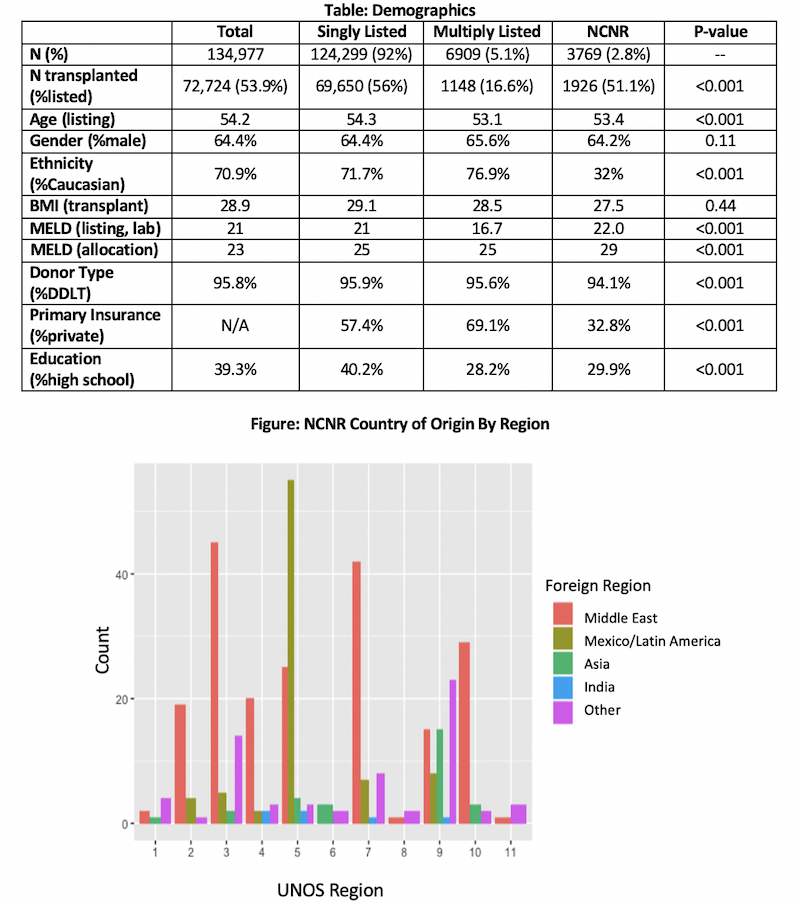Traveling For Transplant: A Comparison of Singly Listed, Multiply Listed, and Non-Citizen Non-Resident Liver Transplant Candidates
1University of California, San Francisco, San Francisco, CA, 2Harvard Medical School, Boston, MA
Meeting: 2020 American Transplant Congress
Abstract number: 579
Keywords: Allocation, Public policy, Resource utilization
Session Information
Session Name: Liver: MELD, Allocation and Donor Issues (DCD/ECD) II
Session Type: Oral Abstract Session
Date: Saturday, May 30, 2020
Session Time: 3:15pm-4:45pm
 Presentation Time: 4:03pm-4:15pm
Presentation Time: 4:03pm-4:15pm
Location: Virtual
*Purpose: Multiply listed (ML) and non-citizen non-resident (NCNR) patients comprise approximately 8% of the liver transplant (LT) waitlist (WL) and approximately 4% of LT recipients. The purpose of this study was to characterize singly listed (SL), ML, and NCNR patients to understand the dynamics of liver allocation among these groups.
*Methods: Using UNOS data, all liver WL candidates from January 1, 2003-December 31, 2017 were reviewed. Re-transplant candidates, pediatric patients, and patients listed for multiple organs were excluded. SL patients were defined as those with a single listing. ML patients were defined as patients with overlapping listing dates prior to their initial transplant or WL removal date. NCNR patients were identified by citizenship status, and included non-resident aliens prior to the classification change in 2012. Demographic variables were compared among the groups using ANOVA and Chi square tests.
*Results: A total of 134,977 individual WL registrants resulting in 72,724 LT were included in the analysis. There were statistically significant differences in nearly all of the demographic variables (Table). Most notably, NCNR patients had a significantly higher percentage of listed patients who progressed to LT compared with ML patients, and tended to have a lower level of education compared with SL and ML patients. ML patients were more predominantly Caucasian, privately insured, and had a higher level of education compared with SL and NCNR patients.
Among 3769 NCNR patients, country of citizenship was available for only 379 (10%). We collapsed country of citizenship into five categories (Mexico/Latin America (MLA), Middle East (ME), Asia, India, other) and compared these groups. MLA patients had significantly higher listing MELD scores (27.7 vs. 20 ME, p=0.01) and a greater proportion of female patients (44.5% vs. 23.2%, p=0.01), and had the greatest proportion of patients in region 5 (61.8% vs. 28.1% ME, p<0.001, Figure).
*Conclusions: Compared with ML patients, a greater percentage of NCNR patients successfully achieve LT. An alarmingly small number (10%) of NCNR patients have documented countries of origin, which indicate two large populations from the Middle East and Mexico/Latin America that have differing patterns in disease severity, listing distribution, and progression to transplant.
To cite this abstract in AMA style:
Braun HJ, Amara D, Shui A, Huang C, Stock PG, Hirose R, Delmonico FL, Ascher NL. Traveling For Transplant: A Comparison of Singly Listed, Multiply Listed, and Non-Citizen Non-Resident Liver Transplant Candidates [abstract]. Am J Transplant. 2020; 20 (suppl 3). https://atcmeetingabstracts.com/abstract/traveling-for-transplant-a-comparison-of-singly-listed-multiply-listed-and-non-citizen-non-resident-liver-transplant-candidates/. Accessed January 8, 2026.« Back to 2020 American Transplant Congress

